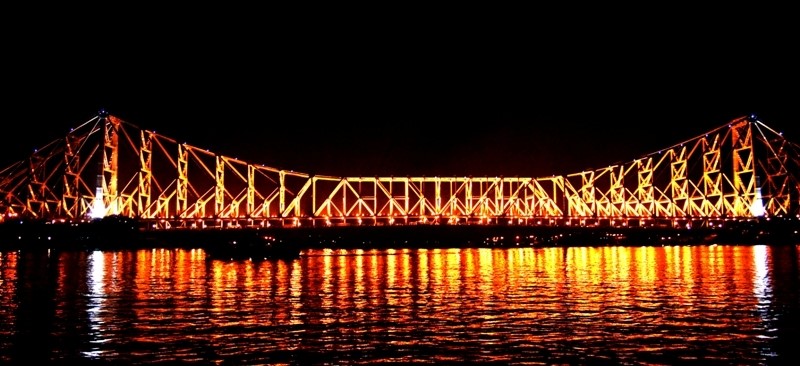
The Howrah Bridge or the Rabindra Setu
The old Howrah Bridge, a floating pontoon Bridge, was opened in October 1874 and made over to Port Commissioners who managed and maintained it. Designed by the late Sir Bradford Leslie, it had a total length of 1528 feet between centers of abutments and provided a 48 feet roadway and two 7 feet footways. The most novel feature was the removal section which when floated out gage a 200 feet clear openings, with a head room of 22 feet, were also provided for smaller crafts. The adjusting ways or shore spans, one at each end of the bridge, consisted of three 160 feet long bow sting girders.
The traffic between commercial Kolkata and industrial Howrah having enormously increased during the first quarter of the 20th Century, the old b ridge was quite insufficient and it was decided to build a new one. The shifting mode of the river Hooghly was dangerous for either a cantilever or a suspension Bridge and hence a Bridge was designed as a sort of combination of the both. It was however known as and a reputed cantilever Bridge and is the third largest bridge of its kind in the World having a over-all length if 2150 feet with a single span of 1500 feet. The new Howrah Bridge was designed by M/s. Rendell, Palmer and Tritton, consulting Engineers. It took 8 years to complete the bridge and 26,000 tons of steel including 18,200 tons of high tensile quality were used. The total cost of construction of the land and all ancillary works, amounted Rs. 3.33 crores.
It is interesting to note that the Bridge expands about 4.8 inches during the heat of the day and contracts equal length in the cool of the night. Another peculiarity of the Bridge is that the Bridge bends over slightly in strong winds. The framework has also been built to withstand earth-quakes, as Calcutta lies in a Seismic zone.
The height of the Bridge at the supporting towers on the both ends in 300 feet. Each tower has a constant width of 11 feet and a tapering from 8’6’’ to 4’6’’ at the top. The entire structure is laid on main piers of re-enforced concrete monoliths with steel ceiling edges. Each pier is 181’6” long by 81’6” wide and is amongst the largest in the world. The monoliths and grinders on Calcutta side are 103 feet deep and on the Howrah side it is 88 feet deep. These monoliths are the heaviest in the world.
The traffic between commercial Kolkata and industrial Howrah having enormously increased during the first quarter of the 20th Century, the old b ridge was quite insufficient and it was decided to build a new one. The shifting mode of the river Hooghly was dangerous for either a cantilever or a suspension Bridge and hence a Bridge was designed as a sort of combination of the both. It was however known as and a reputed cantilever Bridge and is the third largest bridge of its kind in the World having a over-all length if 2150 feet with a single span of 1500 feet. The new Howrah Bridge was designed by M/s. Rendell, Palmer and Tritton, consulting Engineers. It took 8 years to complete the bridge and 26,000 tons of steel including 18,200 tons of high tensile quality were used. The total cost of construction of the land and all ancillary works, amounted Rs. 3.33 crores.
It is interesting to note that the Bridge expands about 4.8 inches during the heat of the day and contracts equal length in the cool of the night. Another peculiarity of the Bridge is that the Bridge bends over slightly in strong winds. The framework has also been built to withstand earth-quakes, as Calcutta lies in a Seismic zone.
The height of the Bridge at the supporting towers on the both ends in 300 feet. Each tower has a constant width of 11 feet and a tapering from 8’6’’ to 4’6’’ at the top. The entire structure is laid on main piers of re-enforced concrete monoliths with steel ceiling edges. Each pier is 181’6” long by 81’6” wide and is amongst the largest in the world. The monoliths and grinders on Calcutta side are 103 feet deep and on the Howrah side it is 88 feet deep. These monoliths are the heaviest in the world.
